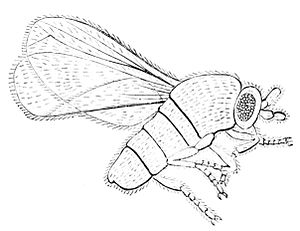| DEVELOPMENT OF THE HOUSE-FLY. |
By M. H. ROBSON.
THE following remarks on the development of the house-fly are based on actual observation, and the appended sketches were made by Mr. G. Harkus from the microscope, with the aid of a Beales reflector.
Mr. Harkus, with whom I experimented simultaneously, was fortunate, or the reverse, in having the required ova brought to him in this way: A fly having gained access to a cold joint of lamb considerately left a sufficient supply for his examination. The objectionable part of the arrangement was probably counterbalanced by his being enabled to fix the time of deposition with tolerable certainty. This was on July 28th. The eggs (one of which is represented in Fig. 3, its diameter one thirtieth of an inch) were placed with a portion of the meat in a glass vessel, and next day the maggots had emerged as in Fig. 4 (diameter one twenty-fifth of an inch), where the ramifications of the tracheal system may be traced.
The warm weather, coupled with the indoor heat, matured the larva rapidly, the change from maggot to chrysalis (Fig. 2) being apparent at each observation, some having assumed this state on July

Fig. 1.—The House-Fly (Musca domestica), magnified.
30th. The perfect stage was reached and the fly emerged on August 5th, or eight days from the deposition of the ova (Fig. 1).
This was a week in advance of the result obtained in my experiment, which I preferred to conduct out of doors. A piece of raw liver was exposed, which soon had eggs enough attached to it. It would appear that the fly has to some extent the power of withholding the
